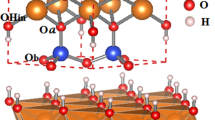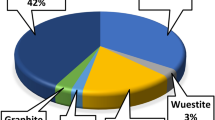Abstract
DURING DC conductance measurements on 0.5 cm thick cylindrical pellets of kaolinite and halloysite at low pressures (10−3–10−4 torr) and high temperatures (500–1,100° C) using platinum electrodes, it was found that potential differences of −8 to +5 V developed across the samples. The magnitude and signs of the voltage peaks changed with temperature and were reproducible for any given clay (Fig. 1). On cooling and reheating the samples several times, two of the peaks were lost and the others reduced in intensity (Fig. 1), but when the mineralogical reactions were completed by heating to 1,400° C no further voltages were obtained. When the sample was held at constant temperature, the voltage showed no tendency to decay away. Reversing the cell leads changed the observed sign but not the magnitude of the voltage. Separate pellets of reagent grade silica and alumina gave no voltages. Voltages were observed with silica–alumina “sandwiches”, but these gave fewer voltage peaks (Fig. 2). Similar effects were observed with bayerite and BDH aluminium silicate (Fig. 2).
This is a preview of subscription content, access via your institution
Access options
Subscribe to this journal
Receive 51 print issues and online access
$199.00 per year
only $3.90 per issue
Buy this article
- Purchase on Springer Link
- Instant access to full article PDF
Prices may be subject to local taxes which are calculated during checkout
Similar content being viewed by others
References
Plaul, Th., Ber. Deut. Keram. Ges., 43, 547 (1966).
Budnikov, P. P., Kostyukov, N. S., and Morgunov, N. N., Dokl. Akad. Nauk SSSR, 170, 640 (1966).
Tauber, K. A. G., and Schmidt, E. R., Nature, 218, 105 (1968).
Taylor, H. F. W., Clay Min. Bull., 28, 80 (1962).
DeKeyser, W. L., Bull. Soc. Fr. Ceram., 62, 19 (1964).
Author information
Authors and Affiliations
Rights and permissions
About this article
Cite this article
MACKENZIE, K. Development of Electric Potentials in Clay Minerals and Alumina—Silica Systems. Nature 222, 469–471 (1969). https://doi.org/10.1038/222469a0
Received:
Issue Date:
DOI: https://doi.org/10.1038/222469a0
This article is cited by
-
Temperature dependence of DC electrical conductivity of kaolin
Journal of Thermal Analysis and Calorimetry (2014)
Comments
By submitting a comment you agree to abide by our Terms and Community Guidelines. If you find something abusive or that does not comply with our terms or guidelines please flag it as inappropriate.



